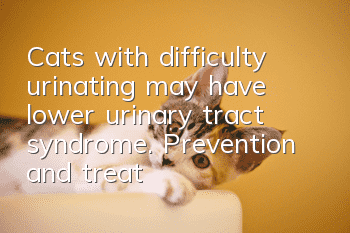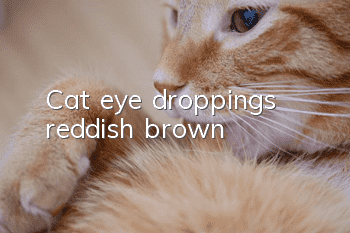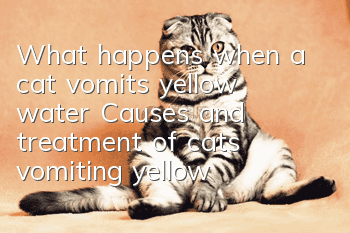Cats with difficulty urinating may have lower urinary tract syndrome. Prevention and treatment methods

Cat lower urinary tract syndrome is not a disease, but a clinical symptom caused by a variety of diseases. It mostly refers to abnormalities in cat urination. If the cat has frequent urination at home, difficulty in urinating, and other We should be careful about strange and abnormal urination behavior.
Its main clinical symptoms include frequent urination, hematuria, painful urination, ectopic urination, frequent licking of genitals, etc. For example, they do not urinate in the cat toilet; secondly, they have difficulty urinating (the sick cat may stay in the cat toilet for a long time, but the cat owner mistakenly thinks it is cat constipation); or the sick cat may cry loudly when urinating. When the condition is serious, the cat may even There will be malaise, partial or complete urinary tract obstruction, leading to azotemia or uremia. It mostly occurs in 1 to 7 years old, and occurs in both male and female cats. Castrated male cats and long-haired cats (especially Persian cats) have the highest incidence rate. Urethral obstruction is more common in males, while cystitis and urethritis are more common in females.
1. Cause:
1. Feeding excessive amounts of dry food containing magnesium is the main cause of lower urinary system syndrome in cats (magnesium in the diet and alkaline urine can easily form magnesium ammonium phosphate crystals).
2. Feed dry food, drink less water, and have thick urine. Crystals or particles in urine can easily form and grow in the bladder and urethra, causing urethral obstruction.
3. Caused by pathogens infecting the lower urinary tract of cats, such as viruses (feline calicivirus, bovine herpes virus type 4, feline syncytium-forming virus), bacteria (staphylococci), mycoplasma, fungi, parasites, etc. , although the pathogen may not be cultured in most cases, antibiotics have a certain effect. The cell fragments produced during cystitis and urethritis are also conducive to the formation of urinary stones;
4. Some tumors of the bladder and urethra, such as fibroma, hemangioma, squamous cell carcinoma, prostate cancer, etc., can cause urethral stricture, bleeding, and even obstruction.
5. Iatrogenic factors, such as catheter probing, flushing, catheters left in the urethra and bladder after surgery, urethrostomy surgery, etc.
6. Factors such as excessive obesity, lack of exercise, acidified or alkalized urine, castration, ovarian removal, and stress may also be the causes of this disease.
7. In addition, some developmental diseases, such as phimosis and urethral stricture; neurological factors such as urethral spasm and bladder paralysis, can also be the cause of cat lower urinary tract diseases.
2. Prevention:
The following measures can help prevent feline lower urinary tract disease:
1. Provide clean, fresh drinking water and change it frequently. Do not put a large amount of drinking water at one time. It is best to put a small amount of drinking water at a time and let the cat drink it before changing it.
2. Cats may not like to drink water with disinfectant added in some areas.It is best to supply distilled water or mineral water.
3. Clean the cat’s toilet bowl frequently and do not let a large amount of cat urine exist in the cat litter.
4. Encourage cats to exercise or play regularly and maintain an ideal weight.
5. Reduce stress on cats.
It is a very important care point to observe your cat’s water drinking and urinary behavior on a daily basis. Giving your cat more attentive care is not only a way to be responsible for your cat, but also a good way to reduce the number of visits to the veterinarian yourself.
Here, we also recommend cat parents to feed their cats professional pet food. Professional wet food can effectively supplement the water needed by cats. Its control of calcium and magnesium can also reduce the risk of cats getting sick; while the salt in dry food can encourage cats to drink water, thus preventing cats from suffering from lower urinary disease. Tao disease.
Secondly, the design and management of B cat toilets are also very important to encourage cats to develop good hygiene habits. Do not place food and drinking water near the toilet; cats usually like quiet and hidden places. Therefore, do not place the toilet in a noisy location, or where the cat may hide, be mobbed, or be unable to escape. For example, when the litter box is located in a storage room or den where another cat can easily block the exit, the blocked cat often has a difficult time escaping while hiding in the litter box. When one cat blocks another cat's access to the litter box (for example, if the litter box is located in a hallway or in a room where the other cat may be blocking the entrance), it can cause the blocked cat to feel extremely stressed in order to avoid the potential rival. Or making it impossible for opponents to reach its area, the cat may defecate.
If your cat exhibits pooping behavior, you will need to choose a different type of cat litter until he makes his choice. In order to evaluate your cat's preference for various types of cat litter, you can put different types of cat litter and different covering thicknesses in different litter boxes. Many cats do not like aromatic cat litter, dusty cat litter, cat litter deodorizers and litter box cushions, etc. Most cats tend to choose odorless clumping litter.
Finally, a warm reminder: clean the sand basin at least once a day and add new sand as needed; clean the sand basin once every 1-4 weeks with soap and hot water to prevent the formation of irritating chemicals and ammonia compounds, which is harmful to the prevention of Cat lower urinary tract disease is beneficial.
- What is the personality of a Siberian cat?
- Common treatment methods and precautions for cat ringworm
- Why do cats like to bite things and how to correct them?
- What types of deworming drugs are available for cats?
- How to prevent cat anuria
- There is black dirt on the kitten’s nostrils
- Why does a cat cough?
- Five types of cats that shed less hair
- Why do cats in heat keep meowing?
- What does it mean when a cat purrs? It doesn’t mean it is asleep!



